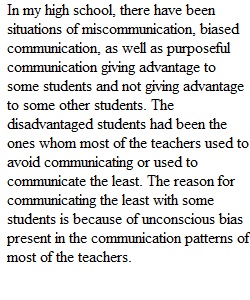


Q Instructions Assignment 3 – Final Project Research Paper, due Tuesday, Week 6 This assignment is worth 35% of your final grade. For your final project in this class, you will research and write a formal paper that uses a communication theory to identify, describe, analyze, and possibly resolve a real-world communication problem in your workplace.* The project will be completed through a combination of discussion board activities and written assignments each week. (*Students who are not employed or who cannot discuss their workplaces may use a communication problem they have experienced in another organizational setting in which they are involved, such as in school or as part of a church or community group.) Objective: This final project is intended to help you understand how knowledge of communication theory supplements the skills you will need to succeed in their careers or personal lives. By completing it, you will achieve the following outcomes: • Develop a research question on an authentic workplace* communication problem • Conduct a relevant academic literature review about a communication theory • Explore your assumptions about the role communication plays in a specific setting in your life • Exercise your critical thinking/analytical skills in researching and analyzing an authentic workplace* communication problem • Apply principles of communication theory to explain and recommend a potential resolution a real-world communication problem. Requirements: 1. Your paper should clearly state your position on, and conclusions about, the workplace* communication problem that you posed in your research question. This means your thesis statement must be supported by researched evidence and reasons, including discussion of at least one relevant communication theory studied in this course. 2. It should be 5-7 pages in length (excluding cover page and reference page) 3. Employ at least 6 credible and authoritative resources, of which at least 3 must be peer-reviewed, scholarly journals. 4. Its ideas must be properly documented with in-text citations and an end-of-text reference list that conform to the seventh edition of the American Psychological Association’s style rules. 5. Specific information from your resources must be employed, properly integrated into the paper as direct quotes, summaries, or paraphrases accompanied by in-text citations that reflect the latest American Psychological Association style rules. No more than three of the direct quotes may be extended or block quotes. 6. Verify the originality of your content and the accuracy of your documentation by reviewing your paper's Turnitin.com report in your assignment folder. Revise the paper as may be needed to improve your use of quoted, paraphrased, and summarized information from the resources that you found in your research. 7. The sources may not include dictionaries, general websites, blogs, Wikipedia, or wiki-type materials. 8. Your paper must be carefully edited and proofread. Format: The paper should follow the general American Psychological Association manuscript rules and contain • an APA-style title page • 12-point font • uniform double-spacing between lines of text • APA-style page headings • paragraphs that are indented • 1” margins Use an abstract at your discretion. Content Guidelines: Your paper should contain at least the following elements. I. Introduction Begin your paper with introductory paragraphs that describe your workplace* communication problem, state your thesis, explain the significance of your inquiry, elaborate on why this question is important to you, and include any other background information that would provide context for your paper. II. Body Paragraphs Summarize the communication theory you have chosen for your project and analyze why it is relevant to the workplace* communication problem that you’re investigating. Explain how an understanding of this theory can be applied to resolving your workplace* communication problem. Describe how you will try to use your knowledge about this theory to addressing and potentially resolving your problem. Support your argument with reasons and evidence from your researched resources. III. Conclusion Summarize the major points you raised in your analysis of your workplace* communication problem and the applicability of the communication theory that you chose to identify, analyze, and possibly resolve it. Grading: For insight into your instructor's expectations for this assignment, scroll down here to click on and review its grading rubric. In general, your project will be evaluated in terms of how well it meets the requirements of the assignment for both content and form; how in-depth the exploration and analysis of the issue is; how well outside sources are integrated into its narrative; the credibility, currency, and authority of its research; how well the theory you chose relates to the problem; and how professionally the paper is written and edited in terms of academic language conventions. If you need help with American Psychological Association citation style, see this examples in our library’s resources. For help developing your paper, see the Effective Writing Center’s online guides to writing and research. Due Date: Submit your final project research paper as a Word .doc, .docx, or .rtf attachment only in its assignment folder under the Assignments link in your classroom by 11:59 p.m. Eastern Time on Tuesday of Week 6. Do not submit the assignment in .pdf, .Gdoc, .Pages, or other format. See the Course Schedule in the syllabus for the exact final due date for this assignment. ©2020 University of Maryland Global Campus
View Related Questions